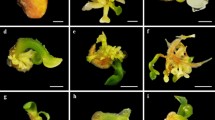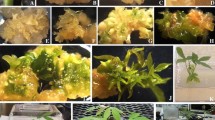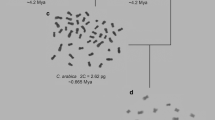Abstract
In vitro micropropagation is an important technique for coffee multiplication performed by somatic embryogenesis, which can be indirect, with the formation of calluses, or direct, when embryos are formed directly from explant cells. In the present study, we characterized the ontogenesis of somatic embryos regenerated via indirect and direct somatic embryogenesis in leaf explants from Coffea arabica ‘Mundo Novo’ and assessed the development of these embryos in leaf explants from adult plants maintained ex situ and in vitro. Anatomical analyses showed that leaf explants present structural differences depending on their origin. In the direct pathway, tissue develops more rapidly in explants from in vitro plants than in those from ex situ explants. In both methods, the formation of a pro-embryogenic mass was found to be essential for embryo formation. In the indirect pathway, calluses from ex situ material presented elongated cells and a loose external appearance. Conversely, calluses from in vitro material presented large regions of meristematic cells with a single large nucleus and dense cytoplasm. We propose that indirect somatic embryogenesis in in vitro–grown explants may accelerate genetic breeding in coffee, and it represents the most efficient condition for somatic embryogenesis, producing embryos in less time than the required by ex situ plants (indirect: 260 d in ex situ conditions, 62 d in vitro; direct: 270 d ex situ, 86 d in vitro).









Similar content being viewed by others
References
Ahmed W, Feyissa T, Disasa T (2013) Somatic embryogenesis of a coffee (Coffea arabica L.) hybrid using leaf explants. J Hortic Sci Biotechnol 88:469–475. https://doi.org/10.1080/14620316.2013.11512993
Alemanno L, Ramos T, Gargadenec A, Andary C, Ferriere N (2003) Localization and identification of phenolic compounds in Theobroma cacao L. somatic embryogenesis. Ann Bot 92(4):613–623. https://doi.org/10.1093/aob/mcg177
Almeida JAS (2020) Observations on somatic embryogenesis in Coffea arabica L. In: Castanheira DT (ed) Coffee-production and research, IntechOpen, London, United Kingdom, pp 1–20. https://doi.org/10.5772/intechopen.90853
Almeida JAS, Carmazini VCB, Da Silva Ramos LC (2007) Indirect effect of agar concentration on the embryogenic response of Coffea canephora. Fruit, Veg Cereal Sci Biotech 1:121–125
Almeida JAS, Silvarolla MB, Fazuoli LC, Stancato GC (2008) Embriogênese somática em genótipos de Coffea arabica L. Coffee Sci 3:143–151
Almeida JAS, Leal R, Carmazini V, Salomon M, Guerreiro Filho O (2014) Effect of temperature and cytokinin on the capacity of direct somatic embryogenesis in Coffea arabica L. genotypes. Coffee Sci 9:394–399. https://doi.org/10.25186/cs.v9i3.668
Almeida JAS, Leal RR, Carmazini VCBM, Salomon MV, Guerreiro-Filho O (2016) Characterization of the morphological events in the somatic embryogenesis in the direct somatic of Coffea arabica L. genotypes. Plant Cell Biotechnol Mol Biol 17:393–403
Alves IS, Carmazini VCB, Santos CD, Almeida JAS (2018) 2-Isopentenyladenine in the induction of direct somatic embryogenesis capacity of Coffea arabica L. Cienc Rural 48:1–5. https://doi.org/10.1590/01038478cr20180001
Appezzato-da-Glória B, Machado SR (2004) Ultrastructural analysis of in vitro direct and indirect organogenesis. Braz J Bot 27(3):429–437. https://doi.org/10.1590/S0100-84042004000300004
Bartos PMC, Gomes HT, Do Amaral LIV, Teixeira JB, Scherwinski-Pereira JE (2018a) Biochemical events during somatic embryogenesis in Coffea arabica L. 3 Biotech 8:1–10. https://doi.org/10.1007/s13205-018-1238-7
Bartos PMC, Gomes HT, Gomes SM, Vasconcelos Filho SC, Teixeira JB, Scherwinski-Pereira JE (2018b) Histology of somatic embryogenesis in Coffea arabica L. Biologia 73(12):1255–1265. https://doi.org/10.2478/s11756-018-0131-5
Berlyn GP, Miksche JP, Sass JE (1976) Botanical microtechnique and cytochemistry. Iowa State University Press, Ames, Iowa
Berthouly M, Michaux-Ferriere N (1996) High frequency somatic embryogenesis in Coffea canephora. Plant Cell Tissue Organ Cult 44:169–176. https://doi.org/10.1007/BF00048196
Brand MH, Lineberger RD (1992) In vitro rejuvenation of Betula (Betulaceae): biochemical evaluation. Am J Bot 79(6):626–635. https://doi.org/10.1002/j.1537-2197.1992.tb14604.x
Carman JG (1990) Embryogenic cells in plant tissue cultures: occurrence and behavior. In Vitro Cell Dev Biol 26:746–753. https://doi.org/10.1007/BF02623615
Carvalho CHS (2008) Cultivares de café: origem, características e recomendações. Embrapa Café, Brasília
Carvalho GR, Mendes ANG, Bartholo GF, Cereda GJ (2006) Comportamento de progênies de cafeeiro cultivar mundo novo. Cienc Agrotec 30(5):853–860. https://doi.org/10.1590/S1413-70542006000500005
Clarindo WR, Carvalho CR, Mendonça MAC (2012) Ploidy instability in long-term in vitro cultures of Coffea arabica L. monitored by flow cytometry. Plant Growth Regul 68:533–538. https://doi.org/10.1007/s10725-012-9740-0
Claudot A, Jay-Allemand C, Magel E, Drouet A (1993) Phenylalanine ammonia-lyase, chalcone synthase and polyphenolic compounds in adult and rejuvenated hybrid walnut tree. Trees 7(2):92–97. https://doi.org/10.1007/BF00225475
David R, Carde J (1964) Histochimie-coloration differentielle des inclusions lipidiques et terpeniques des pseudophylles du pin maritime au moyen du reactif NADI. C R Hebd Séances Acad Sci 258:1338–1340
Dodeman VL, Ducreux G, Kreis M (1997) Zygotic embryogenesis versus somatic embryogenesis. J Exp Bot 48:1493–1509. https://doi.org/10.1093/jxb/48.8.1493
Dublin P (1981) Embryogenèse somatique directe sur fragments de feuilles de caféier Arabusta. Cafe Cacao The 25:237–242
Emons AMC (1994) Somatic embryogenesis: cell biological aspects. Acta Bot Neerl 43:1–14. https://doi.org/10.1111/j.1438-8677.1994.tb00729.x
Fehér A, Pasternak TP, Dudits D (2003) Transition of somatic plant cells to an embryogenic state. Plant Cell Tissue Organ Cult 74:201–228. https://doi.org/10.1023/A:1024033216561
Gaj MD (2004) Factors influencing somatic embryogenesis induction and plant regeneration with particular reference to Arabidopsis thaliana (L.) Heynh. Plant Growth Regul 43:27–47. https://doi.org/10.1023/B:GROW.0000038275.29262.fb
Gatica-Arias AM, Arrieta-Espinoza G, Esquivel AME (2008) Plant regeneration via indirect somatic embryogenesis and optimisation of genetic transformation in Coffea arabica L. cvs. Caturra and Catuaí. Electron J Biotechnol 11:101–112. https://doi.org/10.2225/vol11-issue1-fulltext-9
Gomes HT, Bartos PMC, Balzon TA, Scherwinski-Pereira JE (2016) Regeneration of somatic embryos of oil palm (Elaeis guineensis) using temporary immersion bioreactors. Ind Crop Prod 89:244–249. https://doi.org/10.1016/j.indcrop.2016.05.021
Gregory M, Baas P (1989) A survey of mucilage cells in vegetative organs of the dicotyledons. Israel J Bot 38:125–174. https://doi.org/10.1080/0021213X.1989.10677119
Gulzar B, Mujib A, Malik MQ, Sayeed R, Mamgain J, Ejaz B (2020) Genes, proteins and other networks regulating somatic embryogenesis in plants. J Genet Eng Biotechnol 18:1–15. https://doi.org/10.1186/s43141-020-00047-5
Jiménez VM (2005) Involvement of plant hormones and plant growth regulators on in vitro somatic embryogenesis. Plant Growth Regul 47:91–110. https://doi.org/10.1007/s10725-005-3478-x
Johansen DA (1940) Plant microtechique. McGraw-Hill Book Company, London
Kahia J, Kirika M, Lubabali H, Mantell S (2016) High-frequency direct somatic embryogenesis and plantlet regeneration from leaves derived from in vitro-germinated seedlings of a Coffea arabica hybrid cultivar. HortScience 51:1148–1152. https://doi.org/10.21273/HORTSCI10771-16
Landey RB, Cenci A, Georget F, Bertrand B, Camayo G, Dechamp E, Herrera JC, Santoni S, Lashermes P, Simpson J (2013) High genetic and epigenetic stability in Coffea arabica plants derived from embryogenic suspensions and secondary embryogenesis as revealed by AFLP, MSAP and the phenotypic variation rate. PLoS One 8:e56372. https://doi.org/10.1371/journal.pone.0056372
McIlvaine T (1921) A buffer solution for colorimetric comparison. J Biol Chem 49:183–186
Mendez-Hernandez HA, Ledezma-Rodriguez M, Avilez-Montalvo RN, Juárez-Gómez YL, Skeete A (2019) Signaling overview of plant somatic embryogenesis. Front Plant Sci 10:77. https://doi.org/10.3389/fpls.2019.00077
Menéndez-Yuffá A, De García EG (1997) Morphogenic events during indirect somatic embryogenesis in coffee “Catimor”. Protoplasma 199:208–214. https://doi.org/10.1007/BF01294507
Mishra MK, Devi S, McCormac A, Scott N, Chen D, Elliott M, Slater A (2010) Green fluorescent protein as a visual selection marker for coffee transformation. Biologia 65:639–646. https://doi.org/10.2478/s11756-010-0078-7
Moens P (1965) Developpement de l'ovule et embryogenese chez/Coffea canephora/Pierre. Cellule 65:127–147
Motoike SY, Saraiva ES, Ventrella MC, Silva CV, Salomão LCC (2007) Somatic embryogenesis of Myrciaria aureana (Brazilian grape tree). Plant Cell Tissue Organ Cult 89:75–81. https://doi.org/10.1007/s11240-007-9210-y
Murashige T, Skoog F (1962) A revised medium for rapid growth and bio assays with tobacco tissue cultures. Physiol Plant 15:473–497. https://doi.org/10.1111/j.1399-3054.1962.tb08052.x
Pearse AGE (1985) Histochemistry: theoretical and applied. Churchill-Livingstone, New York
Pierson E, Van Lammeren A, Schel J, Staritsky G (1983) In vitro development of embryoids from punched leaf discs of Coffea canephora. Protoplasma 115(2-3):208–216. https://doi.org/10.1007/BF01279811
Quiroz-Figueroa F, Fuentes-Cerda C, Rojas-Herrera R, Loyola-Vargas V (2002a) Histological studies on the developmental stages and differentiation of two different somatic embryogenesis systems of Coffea arabica. Plant Cell Rep 20:1141–1149. https://doi.org/10.1007/s00299-002-0464-x
Quiroz-Figueroa F, Méndez-Zeel M, Sánchez-Teyer F, Rojas-Herrera R, Loyola-Vargas VM (2002b) Differential gene expression in embryogenic and non-embryogenic clusters from cell suspension cultures of Coffea arabica. J Plant Physiol 159(11):1267–1270. https://doi.org/10.1078/0176-1617-00878
Quiroz-Figueroa F, Rojas-Herrera R, Galaz-Avalos RM, Loyola-Vargas VM (2006) Embryo production through somatic embryogenesis can be used to study cell differentiation in plants. Plant Cell Tissue Organ Cult 86:285–230. https://doi.org/10.1007/s11240-006-9139-6
Ramos L, Yokoo E, Gonçalves W (1993) Direct somatic embryogenesis is genotype specific in coffee. Proceedings of the 15th Colloque Scientifique International sur Le Café, ASIC, pp 763–766
Ravindran BM, Winter S, Thangaraj M (2015) Influence of age of explants and genotype on somatic embryogenesis in African and Indian cassava cultivars. J Root Crops 40(2):21–27
Rezende JC, Carvalho CHS, Santos ACR, Pasqual M, Teixeira JB (2012) Multiplication of embryogenic calli in Coffea arabica L. Acta Sci-Agron 34:93–98. https://doi.org/10.4025/actasciagron.v34i1.11230
Ruaud JN, Bercetche J, Pâques M (1992) First evidence of somatic embryogenesis from needles of 1-year-old Picea abies plants. Plant Cell Rep 11(11):563–566. https://doi.org/10.1007/BF00233093
Sakai WS (1973) Simple method for differential staining of paraffin embedded plant material using toluidine blue O. Biotech Histochem 48:247–249. https://doi.org/10.3109/10520297309116632
Santana-Buzzy N, Rojas-Herrera R, Galaz-Ávalos RM, Ku-Cauich JR, Mijangos-Cortés J, Gutiérrez-Pacheco LC, Canto A, Quiroz-Figueroa F, Loyola-Vargas VM (2007) Advances in coffee tissue culture and its practical applications. In Vitro Cell Dev Biol - Plant 43:507–520. https://doi.org/10.1007/s11627-007-9074-1
Sharifi G, Ebrahimzadeh H, Ghareyazie B, Gharechahi J, Vatankhah E (2012) Identification of differentially accumulated proteins associated with embryogenic and nonembryogenic calli in saffron (Crocus sativus L.). Proteome Sci 10(3):3. https://doi.org/10.1186/1477-5956-10-3
Silva AT, Barduche D, Do Livramento KG, Ligterink W, Paiva LV (2014) Characterization of a putative serk-like ortholog in embryogenic cell suspension cultures of Coffea arabica L. Plant Mol Biol Report 32:176–184. https://doi.org/10.1007/s11105-013-0632-x
Söndahl MR, Sharp WR (1977) High frequency induction of somatic embryos in cultured leaf expiants of Coffea arabica L. Z Pflanzenphysiol 81:395–408. https://doi.org/10.1016/S0044-328X(77)80175-X
Van Boxtel J, Berthouly M (1996) High frequency somatic embryogenesis from coffee leaves. Plant Cell Tissue Organ Cult 44:7–17. https://doi.org/10.1007/BF00045907
Vasconcellos RCC, Almeida JASD, Silvarolla MB (2009) Indução de embriões somáticos em explantes foliares de genótipos de Coffea arabica em presença da citocinina 2-iP. SBICafé, Biblioteca do Café
Vidal BC (1969) Dichroism in collagen bundles stained with Xylidine-Ponceau 2R. Ann Histochim 15:289–296
Vieira LGE, Kobayashi AK (2000) Micropropagação do cafeeiro. Proceedings of the I Simpósio de Pesquisas dos Cafés do Brasil, Consórcio Brasileiro de Pesquisa e Desenvolvimento do Café, pp 147–167. Available via SBICafé. http://www.sbicafe.ufv.br/handle/123456789/536. Cited 25 Jan 2021
Von Aderkas P, Bonga JM (2000) Influencing micropropagation and somatic embryogenesis in mature trees by manipulation of phase change, stress and culture environment. Tree Physiol 20(14):921–928. https://doi.org/10.1093/treephys/20.14.921
Von Arnold S, Sabala I, Bozhkov P, Dyachok J, Filonova L (2002) Developmental pathways of somatic embryogenesis. Plant Cell Tissue Organ Cult 69:233–249. https://doi.org/10.1023/A:1015673200621
Williams EG, Maheswaran G (1986) Somatic embryogenesis: factors influencing coordinated behaviour of cells as an embryogenic group. Ann Bot 57:443–462. https://doi.org/10.1093/oxfordjournals.aob.a087127
Xu L, Huang H (2014) Genetic and epigenetic controls of plant regeneration. Curr Top Dev Biol 108:1–33. https://doi.org/10.1016/B978-0-12-391498-9.00009-7
Yang X, Zhang X (2010) Regulation of somatic embryogenesis in higher plants. Crit Rev Plant Sci 29(1):36–57. https://doi.org/10.1080/07352680903436291
Yasuda T, Fujii Y, Yamaguchi T (1985) Embryogenic callus induction from Coffea arabica leaf explants by benzyladenine. Plant Cell Physiol 26:595–597. https://doi.org/10.1093/oxfordjournals.pcp.a076946
Acknowledgements
The authors thank the Centro de Café Alcides Carvalho (IAC) for providing the plant material used in this study. IFF received a fellowship from CAPES (Coordination for the Improvement of Higher Education Personnel), and JLSM thanks CNPq (310184/2016-9). This study was financed in part by CAPES - Finance Code 001. We would like to thank the Fundo de Apoio ao Ensino, Pesquisa e Extensão (FAEPEX/UNICAMP) for the research support. We also thank the access to equipment and assistance provided by the Electron Microscope Laboratory (LME/UNICAMP).
Author information
Authors and Affiliations
Contributions
IFF, JASA, and JLSM designed the experiments. IFF, GAM, WLSJ, BBB, JASA, and JLSM performed the experiments and analyzed the data. IFF, MPP, and JLSM wrote the manuscript. JMCM revised the manuscript. This study is part of the PhD thesis of IFF (Programa de Pós-graduação em Biologia Vegetal, Instituto de Biologia, Universidade Estadual de Campinas, Brazil). All the authors read and approved the final manuscript.
Corresponding author
Ethics declarations
Competing interests
The authors declare no competing interests.
Additional information
Editor: Yong Eui Choi
Key message
Ontogenesis of somatic embryos from Coffea arabica L. showed that indirect somatic embryogenesis in leaves from in vitro–grown plants produces embryos in less time, reducing tissue culture time.
Rights and permissions
About this article
Cite this article
Ferrari, I.F., Marques, G.A., Junior, W.L.S. et al. Comparative ontogenesis of Coffea arabica L. somatic embryos reveals the efficiency of regeneration modulated by the explant source and the embryogenesis pathway. In Vitro Cell.Dev.Biol.-Plant 57, 796–810 (2021). https://doi.org/10.1007/s11627-021-10200-5
Received:
Accepted:
Published:
Issue Date:
DOI: https://doi.org/10.1007/s11627-021-10200-5




